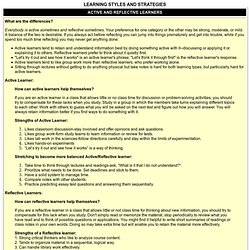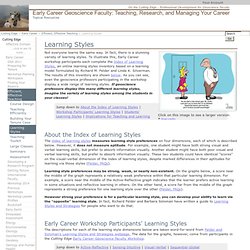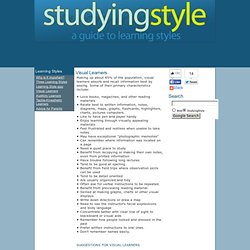

After watching this, your brain will not be the same. LEARNING STYLES AND STRATEGIES. What are the differences?

Many people who read this description may conclude incorrectly that they are global, since everyone has experienced bewilderment followed by a sudden flash of understanding. What makes you global or not is what happens before the light bulb goes on. Sequential learners may not fully understand the material but they can nevertheless do something with it (like solve the homework problems or pass the test) since the pieces they have absorbed are logically connected.
Strongly global learners who lack good sequential thinking abilities, on the other hand, may have serious difficulties until they have the big picture. Even after they have it, they may be fuzzy about the details of the subject, while sequential learners may know a lot about specific aspects of a subject but may have trouble relating them to different aspects of the same subject or to different subjects. Sequential Learners: How can sequential learners help themselves? Learning Styles. Learning Styles. Index of Learning Styles. The Index of Learning Styles is an on-line survey instrument used to assess preferences on four dimensions (active/reflective, sensing/intuitive, visual/verbal, and sequential/global) of a learning style model formulated by Richard M. Felder and Linda K. Overview of learning styles. You Got The Meeting, Now What? Mirror and Match. Rapport is power.

There are people out there you want to influence. They themselves are influencers. And if you are successful, that impact will ripple into the world, multiplying your ability to make a difference — in your home, neighborhood, place of worship, business, or city. They know people, they know what’s happening, they know where resources are. But they won’t listen to you, help you… unless you listen to them, and are interested in helping them. Seek first to understand their needs and concerns. They may simply be family, friends, or co-workers who you must spend time with… and you’d prefer to end all the arguing, getting angry, or completing turning off that part of you which cares deeply about these issues — your true self. Learning Styles. Click on this image to see a larger version.

Cartoon by Bill Browning, from his webpage: Not everyone learns the same way. In fact, there is a stunning variety of learning styles. Www.vark-learn.com/english/page.asp?p=visual. You want the whole picture so you are probably holistic rather than reductionist in your approach.

You are often swayed by the way something looks. You are interested in color and layout and design and you know where you are in your environment. CH03_Concise_Fralick_5e. VAK. Probably because of its simplicity and practicality, VAK theory is widely recognised by teachers - particularly those who advocate Accelerated Learning techniques - but the idea that we receive information via different “modalities” has been around considerably longer than that and can be traced back to the work of Grace Fernald ("Remedial Techniques in Basic School Subjects") who promoted kinaesthetic learning techniques; Samuel Orton’s work on dyslexia; Anna Gillingham’s subsequent work on developing multisensory approaches; and the holistic educational philosophy of Maria Montessori.

Normally, we each have five senses. There is an increasing realisation that we respond subconsciously to our sense of smell. Aromatherapy is based on the principle that aromas can help to create mood. More simply, manufacturers of household products usually try to make them "smell nice". More subtly, perfumers make a living from concocting alluring and enticing odours. Skills for OU Study. Learning Concept Map. What Is My Learning Style. What type of learner are you? Before beginning any kind of learning experience, you must know yourself.

You must especially know yourself based on the learning style categories presented below. Knowing what kind of a learner you are will help you maximize your learning ability and achieve efficient, rewarding results. The first word of the day post has included a picture of the vocabulary word to stimulate visual learners. It has also included a suggestion for a song to stimulate auditory learners. Source: Edudemic.com ( and OnlineCollege.org The pie chart above hints at a very important concept that we believe is central to learning. Like this: Like Loading... 10 Characteristics of Visual Learners. Mastering one test. Helping Visual Learners Succeed. We all want our children to do well in school.

Sometimes though kids struggle with their school work and we’re just not sure how to help. As a school counselor, the first thing I do to help students academically is to identify how they learn. There are three different ways we learn. We either learn by seeing (visual), hearing (auditory), or doing (kinesthetic). Studying Style - A guide to learning styles - Visual Learners. Visual Learners Making up about 65% of the population, visual learners absorb and recall information best by seeing.

Some of their primary characteristics include: Love books, magazines, and other reading materials Relate best to written information, notes, diagrams, maps, graphs, flashcards, highlighters, charts, pictures computers. Like to have pen and paper handy Enjoy learning through visually appealing materials Feel frustrated and restless when unable to take notes. May have exceptional "photographic memories" Can remember where information was located on a page Need a quiet place to study Benefit from recopying or making their own notes, even from printed information Have trouble following long lectures Tend to be good at spelling Benefit from field trips where observation skills can be used Tend to be detail oriented Are usually organized and tidy Often ask for verbal instructions to be repeated Benefit from previewing reading material.
WORST TEST TYPE Listen and respond.